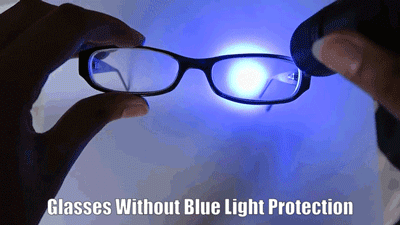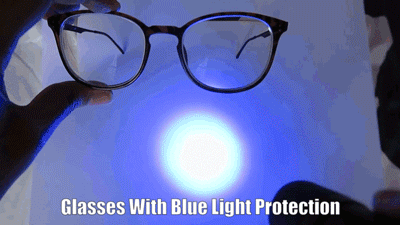How to test blue light blocking glasses

Blue Light and Why Some Glasses Block Blue Light
Blue light is something people contend with every day. It’s a naturally occurring color on the light spectrum. When we are outside, and the sky looks blue, that’s the blue light spectrum visible to our naked eye.
All light is radiation from the sun in the form of wavelengths. Red light is on one end of the spectrum, which is long, gentle wavelengths. Blue light is on the other end of the light spectrum, and it is shorter wavelengths with more energy.
The argument about blue light blocking glasses is not necessarily about all blue light being harmful. That’s not the case. It’s about the blue light emitted from manufactured items such as televisions, computers, phones, and lightbulbs. Because 60% of people spend more than six hours per day looking at screens, they are exposed to more blue light than healthy.
Because too much blue light can interrupt sleep cycles, cause eye strain, and may even cause eye damage, blue light blocking glasses make sense. If you purchase blue light blockers as a healthy, damage prevention tool and sleep aid, you’ll need to know how to verify that they do what they claim - block blue light rays.
How to Test Blue Light Glasses
When deciding how to test blue light glasses, there are several options. Some are more scientific than others. Here are three ways to test your blue light lenses, including a blue light glasses test online.
Spectrum report
There are several ways to test whether your blue light blocking glasses are doing the job intended. You’ll not only want to be sure they are blocking blue wavelengths, but you’ll also want to check how much blue light they block.
One way is to test your glasses is to review their spectrum report. You can request a spectrum report from your eyewear company. Double-check that the glasses you ordered filter at least 30% of blue light. Some companies choose to block 30% of the entire spectrum, which is fine. As long as your glasses are filtering 30% of blue light, you’ll be better protected from extended exposure to blue light that can cause eye strain.
As an added note, if the glasses focus on ultraviolet light, they protect from harmful UV rays, but may not be protecting against blue light, which is what you want in blue blockers.
Blue Light Emitting Pen
You can buy a blue light pen from several online retailers, including Amazon and most eyewear retailers that sell blue light blocking glasses. Be sure that the pen filters 395-450mm, which is the blue light portion of the light spectrum.
The test itself is simple. Hold your glasses over a white background and point the blue light, so it emits through the lenses. If the light is visibly reduced, the glasses are blocking some blue light.
Remember that to be effective, the lenses need to block at least 30% of blue light, so while some blue light will still be emitted through the lenses, you should be able to see a reduction in the amount of blue light.


Test Squares
You can also test your mobile and computer software while testing your blue light blocking lenses.
There are three squares here. They are black, bright blue, and light blue. Take a look at them without your glasses.
If you can’t see any blue on your screen and all images that are supposed to be blue are showing up as black or grey, then your software or screen is already blocking blue light.
If you can see the difference, then it’s time to check your blue light glasses.
Put your glasses on and take another look. Can you see the blue?
If the color doesn’t change, your glasses aren’t working.
If the blue becomes a little less blue and a little more gray, or if it looks reddish or even green, then your lenses are blocking some or even most blue light.
Final Thoughts
While the debate about the utility of blue light blocking glasses rages on, many people have decided to use them to prevent the possibility of damage, strain, and sleep interruptions. If you have blue light blocking glasses, remember that there are ways to protect yourself as a consumer and test your lenses.
You can ask your retailer for their spectrum report, so you know what your glasses claim to filter. You can conduct your own blue light glasses test by trying a blue light pen. Look for a blue light reduction as the pen light is filtered through your lenses. And you can check your screens to detect changes in what blue hues look like on the computer, mobile phone, and television.
Ultimately, the best way to protect yourself is to reduce the amount of time spent on screens that emit manufactured light. However, in today's digital world, spending less than six hours on a screen can prove challenging. Blue light blocking glasses may be the best compromise for your health and safety. Just be sure to do your due diligence as a consumer and conduct a blue light blockers test.
